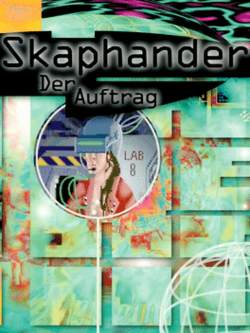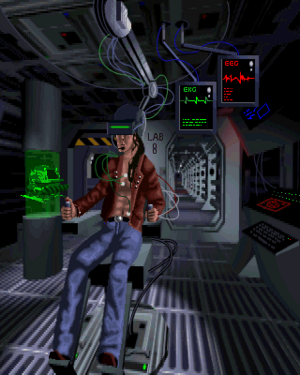
| Skaphander: Der Auftrag | |
|---|---|
| Developer(s) | oP Group |
| Publisher(s) | NAVIGO |
| Year released | 1995 |
| System(s) | DOS |
| Genre(s) | FPS |
|---|---|
| Players | 1 |
| Modes | Single player |
Skaphander: Der Auftrag is a German-language, cyberspace-themed first-person shooter for DOS machines developed by the oP Group (officially called "Oehler & Partner Computer Creations & Virtuality") and published by NAVIGO Multimedia GmbH & Co. Produktions KG. A free demo, containing only the first level, was released in the same year and also translated to English under the title Virus Explosion, but, despite the publisher's original plans, the later levels were only released in Germany.
An updated version of the game was released for Windows in 1997. It features similar gameplay, but also revised storylines, levels, and graphics.
Story[edit]

In the futuristic year of 2007, a hacker by the name of Victor Marazzo is using a brain-computer interface called an HMD to explore cyberspace. Unfortunately, his curiosity gets the better of him, and he is caught breaching the Firm's internal network. The Firm labels him a corporate spy and incarcerates his mind in a lonely sector of the network. But it also has the foresight to retrieve his body and keep him alive.
Fast-forward to March, 2010. The advanced infrastructure supporting society has become deeply enmeshed with a worldwide network of computers, and that proves to be humanity's Achilles's heel when viruses of unknown origin suddenly seize half the net. The Firm, whose two-headed-snake logo is known the world over, has already sent two of their best hackers into cyberspace via an HMD in hopes of finding a solution. Neither made it out mentally intact.
Unwilling to risk more of its valuable employees, the Firm revives Victor, pulling him back to the physical world to make him a once-in-a-lifetime, name-any-price job offer. His reaction is frosty, but ultimately he agrees to try, possibly to avoid looking like a coward, possibly because civilization is on the line, or just possibly because he has a pretty good idea of his life expectancy should he say no.
At the very least, he will be better equipped for this incursion. The Firm is giving him a Skaphander to pilot, a virtual-reality cross between a bulldozer and an armored tank that, like its namesake, is designed to protect him from the dangers of the environment—at least for a little while. The Firm's other hackers have also been able to inject limited resources throughout the network: data, energy, and various virus-hunting equipment is in place for Victor to pick up once he's jacked in. The only question: Will it be enough?
Gameplay[edit]
Skaphander is a puzzle-based vehicular first-person shooter that encourages a more cautious playstyle than most of its contemporaries. For instance, enemies are commonly set up in ambushes, and the player's limited field of view and slow default turn rate means that it is dangerous to enter new areas without scouting them beforehand. Even after combat starts, the AI knows how to retreat, how to hide around corners, how to use cover, and how to exploit the player's aforementioned narrow field of view. Even when not dealing with enemies or environmental hazards, the player's vehicle takes damage if treated roughly, so it is to the player's advantage not to rush about needlessly.
Skaphander's distinctive aiming mechanic also sets it apart from other shooters: the Skaphander normally carries its weapons locked in a fixed, forward-facing position, though they do still rock when the vehicle's suspension has to deal with abrupt maneuvers. But it can release its weapons to pitch them up or down, albeit at the cost of them swinging much more freely from any movement or recoil. Since the Skaphander is bound to the ground while enemies can vary their altitude, that choice creates a number of tactical tradeoffs during firefights.